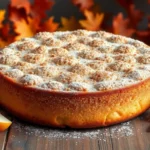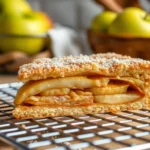We’ve all been there – that sudden craving for something sweet and indulgent hits at the most inconvenient times. When you’re dreaming of rich caramelized cookie flavors but don’t want to commit to baking an entire cake, our Biscoff mug cake becomes your ultimate dessert savior.
This single-serving wonder transforms the beloved Belgian cookie spread into a warm, gooey cake that’s ready in just minutes. With its signature spiced caramel notes and irresistibly soft texture, each spoonful delivers pure comfort in a mug. The beauty lies in its simplicity – no fancy equipment needed, just basic pantry ingredients and your trusty microwave.
Perfect for late-night sweet tooth emergencies or when you want to treat yourself without the leftovers tempting you all week, this Biscoff mug cake proves that the best desserts don’t always require hours in the kitchen. We’re about to show you how five minutes can transform your ordinary evening into something absolutely delicious.
Ingredients
We’ve crafted this Biscoff mug cake recipe to use simple pantry staples that most of us already have on hand. Our ingredient list keeps things minimal while delivering maximum flavor impact from the star ingredient: Biscoff spread.
For the Mug Cake:
- 4 tablespoons all-purpose flour
- 2 tablespoons granulated sugar
- 1/4 teaspoon baking powder
- Pinch of salt
- 3 tablespoons whole milk
- 2 tablespoons Biscoff cookie butter spread
- 1 tablespoon melted butter
- 1/4 teaspoon vanilla extract
For the Optional Topping:
- 1 tablespoon Biscoff spread for drizzling
- 1 crushed Biscoff cookie for garnish
- Vanilla ice cream scoop
We recommend measuring the Biscoff spread when it’s at room temperature for easier mixing. The melted butter should be cooled slightly before adding to prevent scrambling when combined with other ingredients. Fresh ingredients will give us the best texture and rise in our quick microwave creation.
Equipment Needed

Creating our Biscoff mug cake requires minimal kitchen equipment that you likely already have on hand. We only need a few basic tools to transform simple ingredients into this delicious single-serving dessert.
The most important piece of equipment is a large microwave-safe mug with approximately 1½ cup capacity. This size prevents overflow during cooking while providing enough space for the cake to rise properly. Ceramic or glass mugs work best as they distribute heat evenly throughout the cooking process.
For mixing our batter, we’ll use either a small whisk or fork. Both options effectively combine ingredients and break up any lumps in the flour. A fork works particularly well for mashing the Biscoff spread into the other ingredients.
Measuring spoons ensure accuracy when portioning our ingredients. Precise measurements make the difference between a perfectly moist cake and one that’s too dense or dry. We recommend having both tablespoon and teaspoon measurements available.
Finally, we’ll need access to a microwave for cooking our creation. Different microwave wattages affect cooking times, so we’ll start with shorter intervals and adjust as needed. Most standard home microwaves between 700-1000 watts work perfectly for this recipe.
| Equipment | Purpose | Size/Type |
|---|---|---|
| Microwave-safe mug | Cooking vessel | 1½ cup capacity |
| Small whisk or fork | Mixing batter | Standard size |
| Measuring spoons | Ingredient accuracy | Tablespoon and teaspoon |
| Microwave | Cooking method | 700-1000 watts |
Instructions
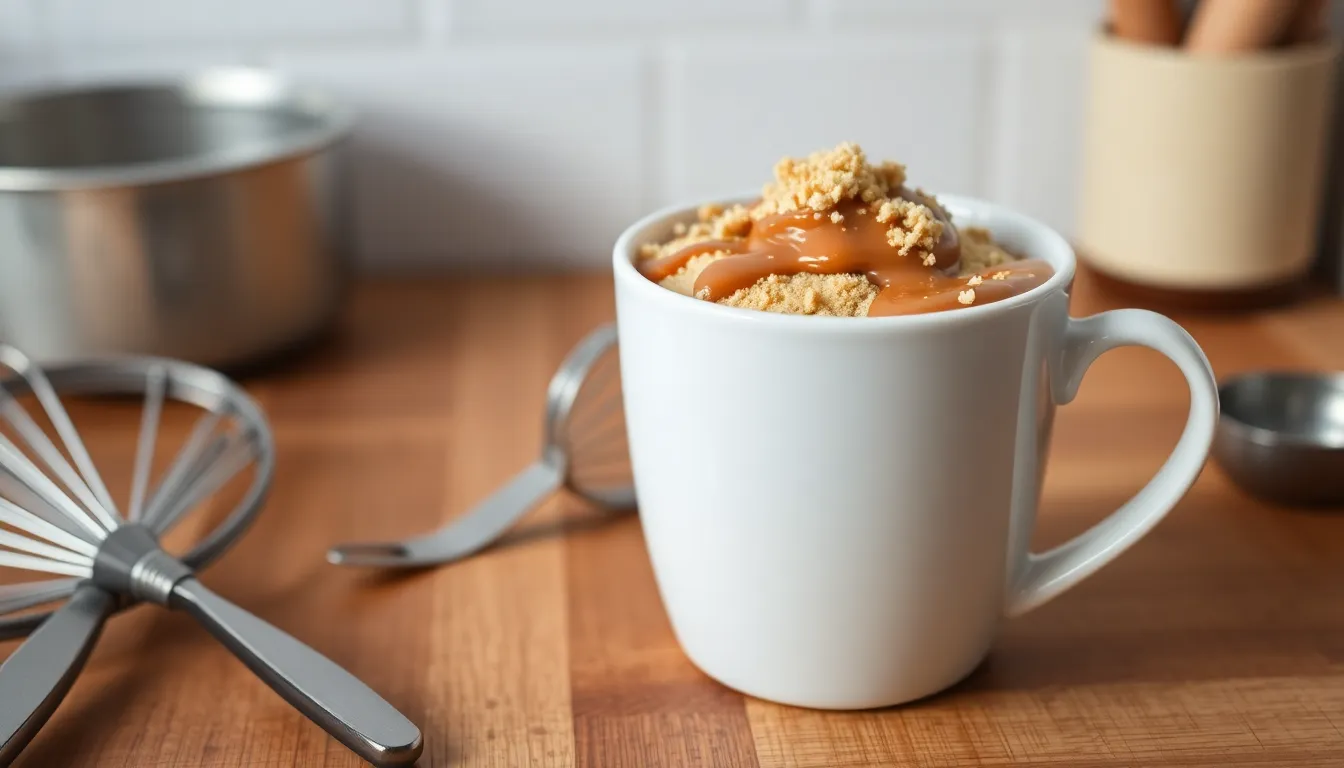
Follow our simple step-by-step process to create your perfect Biscoff mug cake in just minutes. Each stage builds upon the previous one to ensure optimal texture and flavor.
Prep the Mug
Start by selecting a microwave-safe mug that holds at least 10-12 ounces of liquid. We recommend ensuring the mug is completely clean and dry before beginning. This larger capacity prevents overflow during cooking and allows proper rising space for our cake.
Mix Dry Ingredients
Combine 4 tablespoons of all-purpose flour with 3 tablespoons of caster sugar directly in your prepared mug. Add ¼ teaspoon of baking powder and a pinch of salt to enhance the overall flavor profile. Stir these dry ingredients together using a small whisk or fork until well combined and no lumps remain.
Combine Wet Ingredients
Soften 3 tablespoons of Biscoff spread in the microwave for a few seconds to make mixing easier. Add 3 tablespoons of whole milk and 3 tablespoons of vegetable oil to the softened spread. Include ¼ teaspoon of vanilla extract for enhanced flavor depth. Whisk these wet ingredients together in a separate small bowl until the mixture becomes smooth and uniform.
Assemble the Batter
Pour the wet ingredient mixture into your mug containing the dry ingredients. Use your small whisk or fork to combine everything thoroughly until no flour streaks remain visible. Avoid overmixing the batter as this can result in a tough texture rather than our desired tender crumb.
Microwave the Cake
Place the mug in your microwave and cook for 60 seconds initially. Check the cake’s doneness and continue cooking in 30-second intervals if needed. Total cooking time typically ranges from 1.5 to 2 minutes depending on your microwave’s wattage. The cake is ready when it springs back lightly when touched and appears set on top.
Serving Suggestions
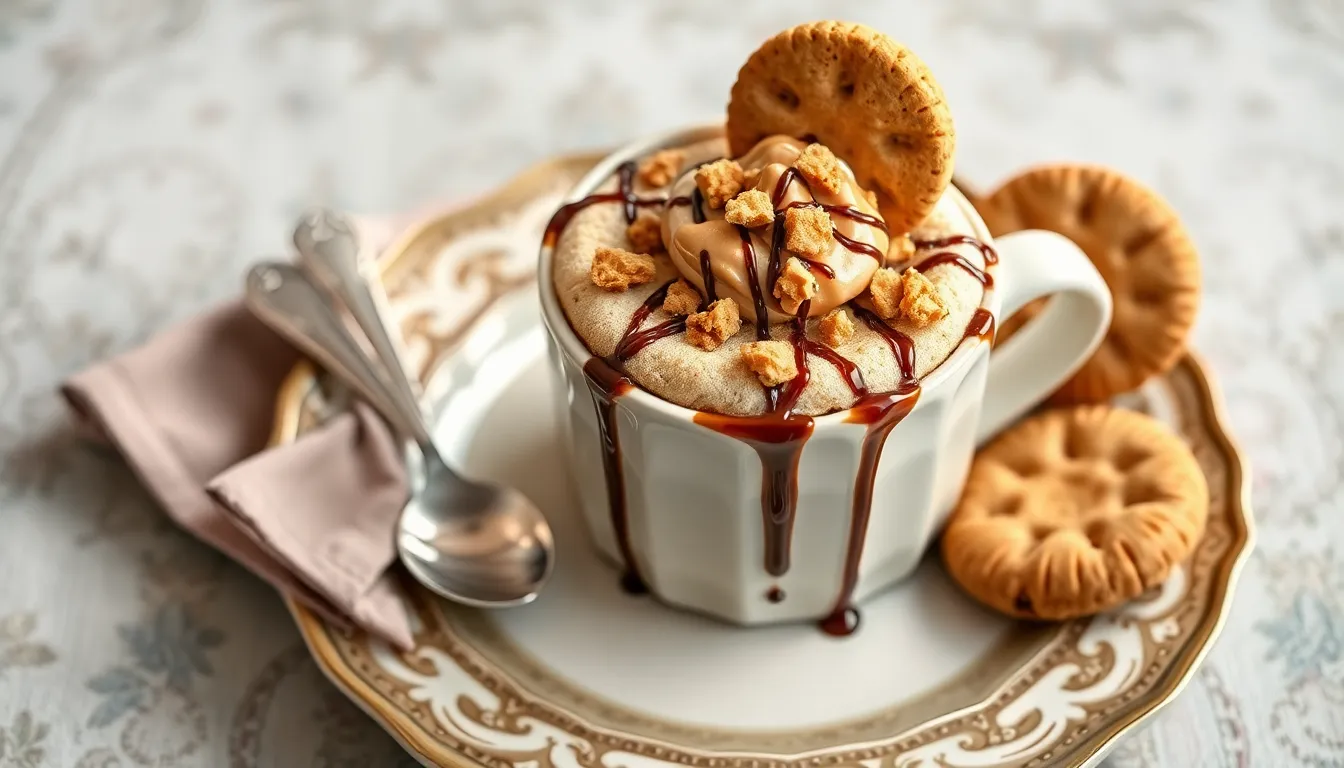
We recommend serving your freshly made Biscoff mug cake warm straight from the microwave for the ultimate comfort dessert experience. The beauty of this single-serving treat lies in its convenience – you can enjoy it directly from the same mug used for baking to retain maximum heat and minimize cleanup.
Toppings and Add-Ins
We love improving our Biscoff mug cake with an additional dollop of Biscoff cookie butter on top for extra richness and that signature caramelized flavor. Crumbled Biscoff cookies create delightful texture contrast while a scoop of vanilla ice cream transforms this simple treat into an indulgent dessert experience.
For chocolate lovers, we suggest drizzling melted chocolate over the warm cake or folding chocolate chips directly into the batter before microwaving. Whipped cream adds a light, airy element that balances the dense cake texture beautifully. A light dusting of powdered sugar provides an elegant finishing touch that photographs wonderfully.
Mix-in options include chopped nuts for crunch or a pinch of cinnamon stirred into the batter for warm spice notes. These additions should be incorporated before microwaving to ensure even distribution throughout the cake.
Presentation Ideas
We create appealing presentations by swirling additional Biscoff spread on the surface using a knife tip or toothpick for an artistic drizzle pattern. Placing a whole Biscoff cookie on the side of the mug adds visual interest and provides an extra treat for dipping.
For a classic dessert shop appearance, we top the warm cake with a scoop of vanilla ice cream and insert a Biscoff cookie vertically into the ice cream. Drizzling melted chocolate in decorative patterns over the entire presentation elevates the visual appeal significantly.
Sprinkling cookie crumbs or chocolate shavings around the rim of the mug creates a professional bakery look. We often add a small spoon alongside the mug on a decorative plate with a cloth napkin for an elevated serving presentation that guests appreciate.
Storage and Reheating Tips
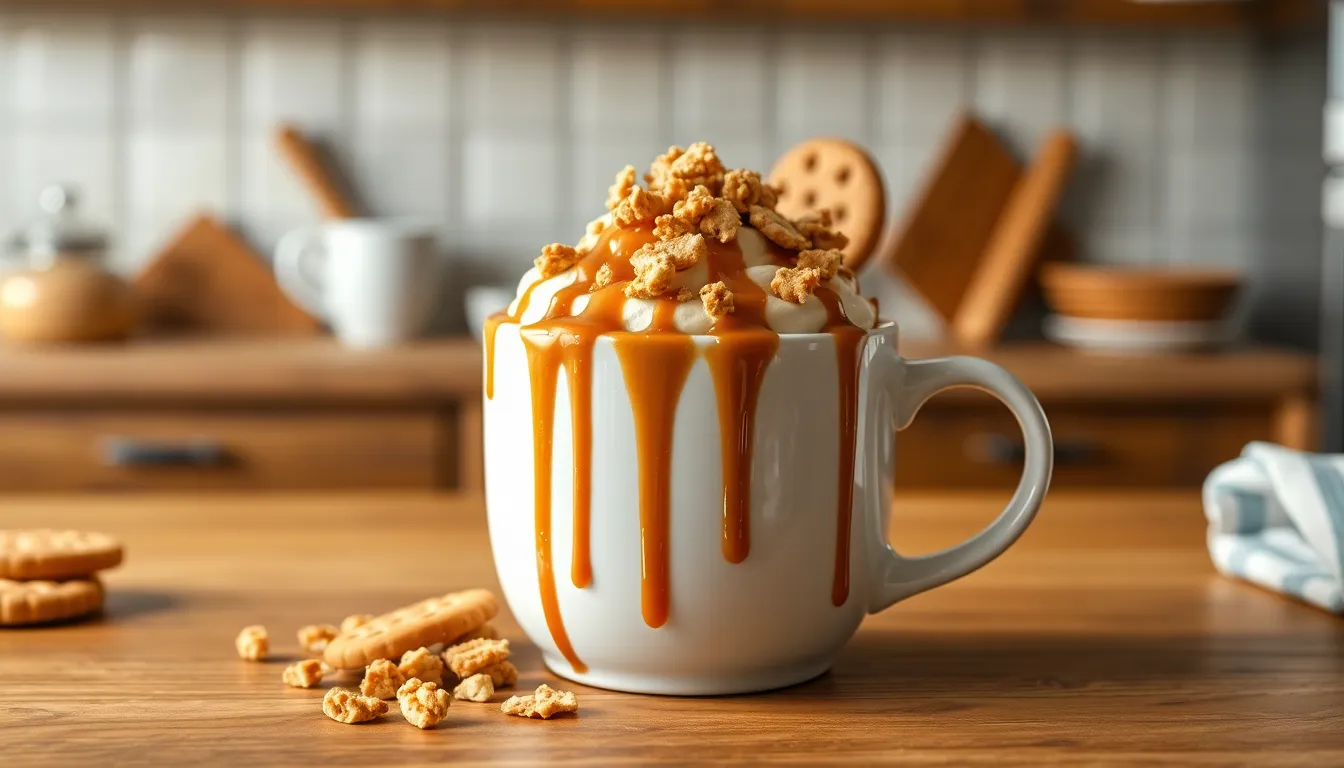
Our Biscoff mug cake tastes best when enjoyed fresh from the microwave. But, we understand that sometimes you might want to save your delicious creation for later or prepare it ahead of time.
Room Temperature Storage
We recommend storing cooled mug cakes in an airtight container at room temperature. The cake maintains its texture and flavor when consumed within one day of preparation. Make sure the cake has completely cooled before placing it in storage to prevent condensation buildup.
Refrigeration Options
Refrigerating your mug cake creates a firmer texture while extending its shelf life up to two days. We suggest wrapping the cake tightly in plastic wrap or aluminum foil before refrigerating. This method works particularly well if you prefer a denser cake texture or need to store multiple servings.
| Storage Method | Duration | Best For |
|---|---|---|
| Room Temperature | 1 day | Maintaining soft texture |
| Refrigeration | 2 days | Firmer texture preference |
| Freezing | 1 month | Long-term storage |
Freezing for Extended Storage
We can freeze cooled mug cakes for up to one month when properly wrapped. Place the tightly wrapped cake in a freezer-safe bag to prevent freezer burn and maintain quality. This option proves helpful when you want to prepare multiple servings in advance.
Microwave Reheating
We recommend reheating your stored cake in the microwave for 10 to 20 seconds to restore its warmth and original texture. Start with shorter intervals to avoid overheating. The microwave method brings back that fresh-baked warmth we all love.
Oven Reheating Method
Our oven reheating technique provides more even heating throughout the cake. Preheat your oven to 300°F (150°C) and warm the cake for 5 to 7 minutes until heated through. This method works especially well for refrigerated cakes that need gentle warming.
Improving Reheated Cakes
We love adding fresh toppings to reheated mug cakes to restore their appeal. Drizzle warm Biscoff spread over the reheated cake for added flavor and moisture. Sprinkle crushed Biscoff cookies on top for extra crunch or serve with a scoop of vanilla ice cream for a delightful temperature contrast.
Recipe Variations
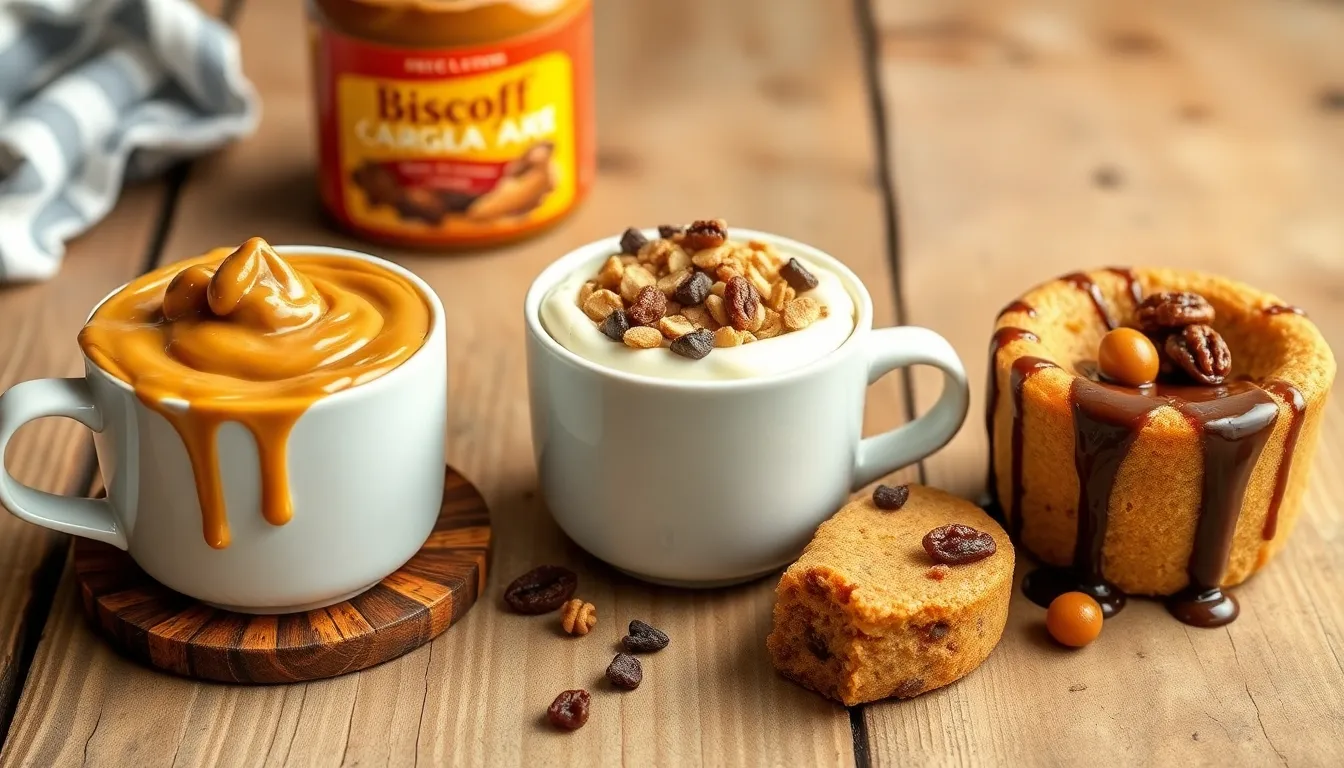
We can easily customize our basic Biscoff mug cake recipe to accommodate different dietary needs and flavor preferences. These variations maintain the same quick preparation time while offering exciting new ways to enjoy this delightful dessert.
Vegan Biscoff Mug Cake
We can create a plant-based version by making simple ingredient swaps that deliver the same rich Biscoff flavor. Start with 2.5 tablespoons of Biscoff spread as our base, then combine 4 tablespoons of all-purpose flour with 0.5 teaspoon of baking powder. Add 1.5 tablespoons of brown sugar for sweetness, then mix in 4 tablespoons of your favorite plant-based milk and 1 tablespoon of vegetable oil. The cooking method remains identical to our original recipe, microwaving for 60 seconds and adjusting as needed. Top with melted Biscoff spread and crushed Biscoff cookie crumbs for the perfect finishing touch.
Gluten-Free Option
We recommend substituting our all-purpose flour with a quality gluten-free flour blend to accommodate those with gluten sensitivities. Use the same measurement of gluten-free flour as called for in the original recipe, ensuring it contains xanthan gum for proper texture. Check that your baking powder is certified gluten-free, as some brands may contain gluten-based ingredients. The remaining ingredients and cooking instructions stay exactly the same, producing a cake with comparable taste and texture to the traditional version.
Extra Indulgent Version
We can transform our basic mug cake into an over-the-top dessert experience with several decadent additions. Stir a tablespoon of Nutella into the batter for a chocolatey twist, or drizzle chocolate syrup over the finished cake. Add chopped walnuts or pecans directly to the batter for delightful crunch and nutty flavor. Enhance the warmth with a pinch of cinnamon or freshly grated nutmeg mixed into the dry ingredients. For fruit lovers, fold in raisins or other dried fruits before microwaving to add natural sweetness and chewy texture contrasts.
Troubleshooting Tips
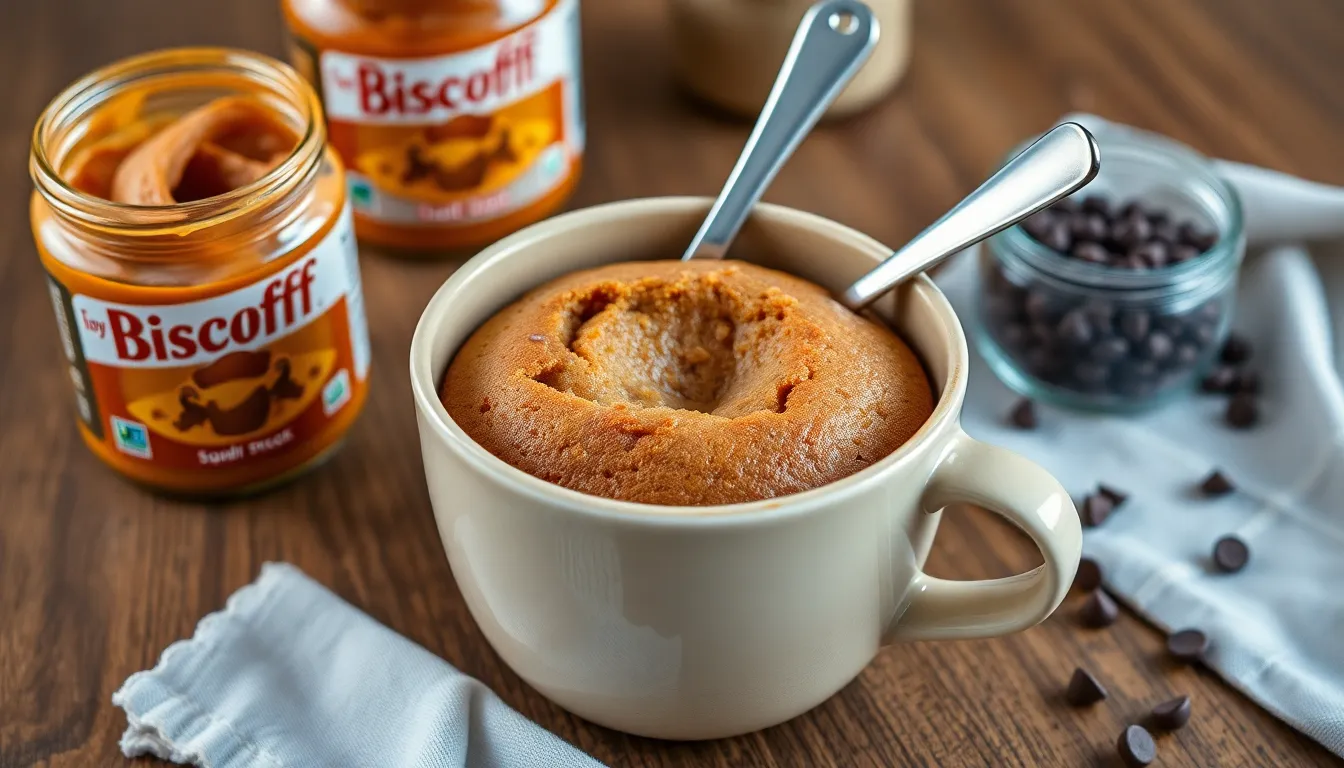
Even with our straightforward Biscoff mug cake recipe, we sometimes encounter minor issues that can affect the final result. We’ve compiled the most common problems and their answers to help you achieve perfect results every time.
Dry Mug Cake Issues
When our mug cake turns out dry and crumbly, we typically identify two main culprits. Overcooking remains the primary cause of this texture problem. We recommend reducing the initial cooking time and checking our cake at 10-second intervals to prevent moisture loss. Overmixing the batter also contributes to dryness by developing too much gluten in the flour. We suggest mixing just until the ingredients combine smoothly without any streaks.
Wet or Undercooked Cake Problems
Insufficient cooking time leads to a wet, gooey center that hasn’t properly set. We return the cake to the microwave for additional 10 to 30-second intervals when this occurs. Our cake should feel spongey when properly cooked, not squishy or overly firm. We check the texture by gently pressing the center with our finger between each heating interval.
Overflow and Spillage Answers
Using a mug that’s too small causes batter overflow as the cake rises during cooking. We always select a mug with at least 1½ cup capacity to accommodate the expanding batter. A small bowl works as an alternative when we don’t have a sufficiently large mug available.
Essential Preparation Tips
Breaking up lumps in our baking powder before mixing prevents bitter flavors from developing in the finished cake. We sift or whisk the baking powder with our dry ingredients to ensure even distribution. Microwave wattage variations affect cooking times significantly, so we adjust our timing based on our exact appliance. Standard home microwaves between 700 to 1000 watts work well with our recommended cooking intervals.
Flavor Enhancement Options
We can elevate our basic recipe by incorporating white or milk chocolate chips directly into the batter. Swirling extra Biscoff spread through the mixed batter creates delicious pockets of concentrated flavor. Sprinkling caster or raw sugar on top before microwaving adds a delightful crunchy texture contrast to our soft cake.
Conclusion
We’ve shown you how simple it can be to create a decadent dessert in minutes with this Biscoff mug cake recipe. The beauty lies in its simplicity – basic ingredients you likely have on hand transform into a warm indulgent treat without any fuss.
Whether you’re craving something sweet after dinner or need a quick pick-me-up during the day this single-serving cake delivers every time. The versatility means you can customize it to your heart’s content or keep it classic.
Next time you’re hit with a dessert craving remember that satisfaction is just minutes away. Grab your favorite mug and let this foolproof recipe become your go-to solution for instant sweet happiness.
Frequently Asked Questions
How long does it take to make a Biscoff mug cake?
The Biscoff mug cake takes only a few minutes to prepare and cook. The mixing process takes about 2-3 minutes, and the microwave cooking time is typically 60-90 seconds. From start to finish, you can have a warm, delicious dessert ready in under 5 minutes total.
What ingredients do I need for a Biscoff mug cake?
You’ll need 4 tablespoons all-purpose flour, 2 tablespoons granulated sugar, 1/4 teaspoon baking powder, a pinch of salt, 3 tablespoons whole milk, 2 tablespoons Biscoff cookie butter spread, 1 tablespoon melted butter, and 1/4 teaspoon vanilla extract. All ingredients are common pantry staples.
What size mug should I use for the Biscoff mug cake?
Use a large microwave-safe mug with a capacity of approximately 1½ cups or 10-12 ounces. This size prevents overflow during cooking and allows the cake to rise properly. Ceramic or glass mugs work best, and avoid metal containers in the microwave.
Can I make a vegan version of the Biscoff mug cake?
Yes, you can make a vegan version by substituting plant-based milk for whole milk, using vegan butter or oil instead of regular butter, and ensuring your Biscoff spread is vegan-friendly. The cooking time and method remain the same for delicious vegan results.
How do I store leftover Biscoff mug cake?
Store cooled mug cake in an airtight container at room temperature for up to one day or refrigerate for up to two days. For longer storage, wrap properly and freeze for up to one month. Reheat in the microwave for 10-20 seconds or oven at 300°F for 5-7 minutes.
Why is my Biscoff mug cake dry or crumbly?
A dry or crumbly texture usually results from overcooking or overmixing the batter. Reduce cooking time by 10-15 seconds and mix ingredients just until combined. Also, ensure your Biscoff spread is at room temperature for easier mixing and better moisture distribution.
Can I add toppings to my Biscoff mug cake?
Absolutely! Popular toppings include extra Biscoff spread, crumbled Biscoff cookies, chocolate chips, whipped cream, vanilla ice cream, or a drizzle of melted chocolate. Add toppings after cooking for the best texture and presentation.
What microwave wattage works best for this recipe?
Most standard home microwaves between 700-1000 watts work well for this recipe. Start with 60 seconds and add 10-15 second intervals as needed. Lower wattage microwaves may require slightly longer cooking times, while higher wattage ones may need less time.







